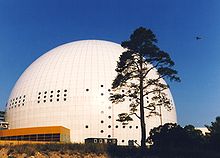Enskede-Årsta-Vantör
Enskede-Årsta-Vantör is a municipality in Stockholm . It was created on January 1, 2007 by amalgamating the Enskede-Årsta and Vantör districts.
The city district is separated from central Stockholm by a bay of Lake Mälaren , the Årstaviken . About 81,000 people live in the city district. Here is the Skogskyrkogården cemetery , which is a World Heritage Site.
structure
Enskede-Årsta-Vantör is divided into the following areas.
Gamla Enskede
The area of this district was bought by the City of Stockholm in 1904 and has been developed since 1908. According to the plans of Per Olof Hallmans, Stockholm's first garden city was built here . In some places, terraced houses based on the English model were built and in other areas, semi-detached and single-family houses were built. In the middle of the small villas stands the church of Enskede Enskede kyrka , built in 1916 according to the plans of the architect Carl Bergsten .
Enskede Gård
This district also became the property of Stockholm in 1904. The development consists mainly of small single-family houses, but there are also multi-storey buildings.
Årsta
The area has belonged to Stockholm since 1905 and until the 1940s there were only allotment gardens here . In 1942 the first apartment houses were built in the east of the district. Originally a subway line was also supposed to be built, but these plans were never realized. When the municipal center Årsta centrum by the architects Erik and Tore Ahlsén was inaugurated with a cultural center, theater, cinema and shops, the western part of the district was also built on.
In the north, Årsta is bordered by a long Mälaren bay, Årstaviken.
Johanneshov
This district is best known for its large sports facilities. The multi-purpose arena Globen , the ice stadium Hovet, the Tele2 arena and the former Söderstadion are located here . The Tele2 Arena is the home of the football clubs Hammarby IF and Djurgårdens IF .
The first residential buildings were built in Johanneshov around 1940 and the communal center is located at the Gullmarsplan underground station.
Ostberga
Östberga is dominated by larger industrial parks. There are warehouses and a post office here, but also development areas and a golf course .
To the west of Östberga are the “food halls ” Årsta Partihallar from Stockholm. Årsta Partihallar is a wholesale center for mainly fruit, vegetables, fish and flowers that opened in 1962. In recent times, the trading center has become an all-encompassing food hub, the "pantry of Stockholm". In 2007 the center comprised a good 20 buildings on an area of around 300,000 square meters. Around 200 companies operate wholesalers there with annual sales of around 900 million crowns.
Stureby
Since 1921, mainly single-family houses have been built in this district. The name of the district refers to Sten Sture the Younger , who fought a victorious battle against King Christian II here.
Vantör
The residential areas of Vantör emerged mainly in the 1950s and 1960s in connection with the expansion of the Stockholm subway. The only exception is the villa district Örby, which was laid out at the end of the 19th century.
Other districts are Bandhagen, Högdalen, Rågsved and Hagsätra.
Sons and Daughters of the Borough
- Leni Björklund (* 1944), politician and general secretary of the Church of Sweden
- Lasse Berghagen (* 1945), musician
- Hans Jacobson (1947–1984), modern pentathlon and epee fencer, Olympic champion
- Håkan Lans (* 1947), engineer and inventor
- Harpo (born 1950), pop singer
- Wanja Lundby-Wedin (* 1952), trade unionist
- Kjell Bergqvist (born 1953), actor
- Cats Falck (1953–1984), television journalist
- Gunnel Fred (* 1955), film actress
- Linda Haglund (1956-2015), track and field athlete
- Anna Lindh (1957–2003), politician (SAP)
- Cecilia Nilsson (born 1957), actress
- Thomas Dennerby (* 1959), soccer player and coach
- Benny Lekström (* 1981), soccer player
- First Aid Kit , that's Johanna Söderberg (* 1990) and Klara Söderberg (* 1993), singing duo
additional
Parts of the Swedish feature film Verdammnis from 2009 are set in Enskede.
Web links
- Homepage (Swedish)
Coordinates: 59 ° 17 ' N , 18 ° 5' E





